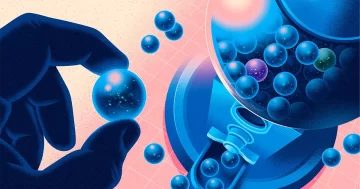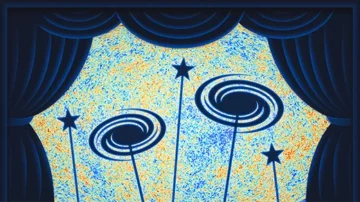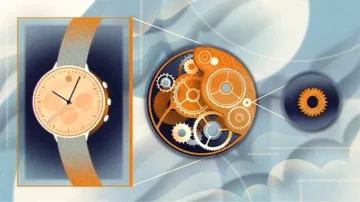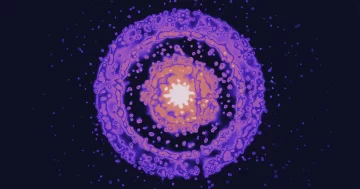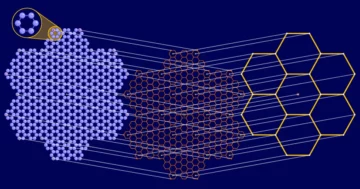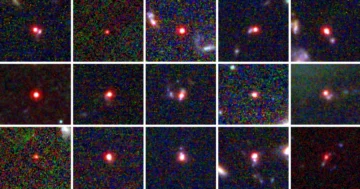Stripes of gas wind and wrap through the darkness, twisting into knots that are poised to collapse into stars. And it all happens in the palm of Nia Imara’s hand.
The stormy clouds of gas and dust where stars are born remain scientific enigmas. But Imara, who is a visual artist as well as an astrophysicist at the University of California, Santa Cruz, brings them to life. She toys with computer simulations of molecular clouds (as they’re called), adjusting the turbulence, gravity and magnetic field settings to see how these parameters affect the storms that rage within. Then she casts the data into baseball-size spheres of resin with a 3D printer — layer by layer, each one-third the thickness of a sheet of paper. These sculptures of stellar ultrasounds have helped Imara study the processes guiding star formation more intimately than ever before.
Imara has made significant advances over the past decade in understanding molecular clouds. Her investigation sprang from a quest for cosmic belonging. Many of the elements in our bodies — elements necessary for life — were forged in stars. And the “grandparents” and “parents” of stars, in Imara’s words, are the hydrogen atoms and molecules swirling inside molecular clouds. A native Californian, Imara began studying the clouds’ properties as a graduate student at the University of California, Berkeley, where, in 2010, she became the school’s first Black woman to earn her doctorate in astrophysics.
Then, as a postdoctoral researcher at Harvard University, Imara used the Atacama Large Millimeter/submillimeter Array (ALMA), a string of radio telescopes in Chile, to observe molecular clouds at high resolution in distant dwarf galaxies. By comparing various clouds, she has learned to identify structures and patterns in the cold darkness of space. She has highlighted regions where new generations of stars are likely to form and developed a model for how the star formation rate in a galaxy evolves alongside properties of the galaxy’s dust.
Studying the genealogy of the elements reminds Imara that “we’re all connected — quite literally, we all come from stars.” She sees science as “the birthright of all humanity” and is committed to helping counteract the systemic racism that prevents people of color from participating in and benefiting from science fully. Two years ago, she started a nonprofit that offers free math and science tutoring for students of color. Imara also recently initiated a partnership between the University of California, Santa Cruz and the Ghana Radio Astronomy Observatory, a telescope refurbished from a telecommunications dish that’s managed and operated by scientists in West Africa.
Quanta Magazine spoke with Imara recently about her attempts to see stars before they’re born. The interview has been condensed and edited for clarity.
Let’s start with the basics. What do we know so far about how stars form?
Although stars give us light, the life of a star begins in darkness. In order for a star to form, we need conditions in interstellar space where gas can compress to a high enough density such that nuclear fusion can start to take place. But many regions of space are actually quite hot — often hot enough to strip atoms of their electrons and ionize them — and ionized gas resists compression. So whenever we see stars forming, they’re inside of these vast complexes that we call molecular clouds or stellar nurseries, where the gas is largely neutral. Physical processes taking place within the clouds help the gas to cool down so that gravity can become effective and compress it into stars.
As for how these stellar nurseries themselves form, there are still many open questions.
Why is that? What makes the clouds so hard to study?
The main component of molecular clouds is the hydrogen molecule, which is two hydrogen atoms bonded together. But molecular hydrogen is actually really hard to detect because of its quantum mechanical properties. On top of that, the interstellar dust within molecular clouds obscures much of the optical and ultraviolet light associated with these regions, which makes them even harder to detect.
How do you see inside the clouds, then?
We have to resort to tracer molecules — other compounds that exist within these clouds. Carbon monoxide is the main molecule we use, and although it’s far less abundant than molecular hydrogen, it’s the second-most abundant molecule. And carbon monoxide shines brightly enough that we can use it to infer the overall properties that we’re interested in measuring, such as a cloud’s mass and volume density. We can also use dust to trace the properties of stellar nurseries.
I thought dust was hindering observations. But you’re saying we can also learn about star formation from the dust.
Dust is the bane of many astrophysicists, but I love dust because it’s telling us something interesting and useful.
Dust facilitates the formation of hydrogen molecules, which form most efficiently on the surface of dust grains. So where there is star-forming gas, there is usually dust, which absorbs starlight and re-emits it at longer wavelengths. By observing the way dust extinguishes starlight, or observing the light it re-emits, we can use dust to trace properties of stellar nurseries as well as processes associated with star formation.
But to make that leap — to connect dust radiation to the star formation rate, for instance — you have to make assumptions about the properties of dust, like its temperature, which can be nontrivial to do. To better understand interstellar dust in galaxies, my colleagues and I built a model to trace how the dust’s mass and temperature vary with other galactic properties — like stellar mass and star formation rate — over cosmic time.
Certainly if you’re an optical astronomer, dust may cause all sorts of problems if you’re not careful. But for people interested in star formation, dust isn’t something to be feared — it’s another way to map out what’s going on inside these clouds.
And what is going on inside the clouds?
When we look at pictures of molecular clouds, we find that they’re extremely complicated in terms of their geometry. They have all of this intricate, elaborate structure. In many ways, they’re much more complex morphologically than a star, which can essentially be approximated as a sphere. Molecular clouds are filled with these long, skinny, over-dense structures called filaments. And the places within the clouds where we tend to find stars forming are at the dense intersections of these filaments. It’s the highest-density gas that’s most likely to collapse and produce stars.
Are the filaments helping stars form?
We think so. We’ve come to understand that the complex substructures in giant molecular clouds actually play a critical role in star formation. For example, inside the California Molecular Cloud, which is located within the constellation Perseus, there’s this small region in the center that looks like an X, which we identified and named California-X. From our carbon monoxide observations, we gleaned that its structure is funneling streams of gas to local sites of star formation.
But here we find another reason why these processes are so difficult to study. We know that molecular clouds are elaborate, and that their complex geometry is tied to star formation. But the images we have of them are flat — they’re inherently two-dimensional. We want to get a sense of what’s happening in the third dimension. We have to use what we know about physics to make our best guesses about the density of gas within the depth of the image. Our understanding depends on our ability to interpret what’s going on visually — to identify and characterize certain patterns that we see. And we can miss some crucial information when we’re looking at two-dimensional images.
You managed to bring that data into the third dimension with your 3D-printed orbs. What are the sculptures teaching you about the inner workings of molecular clouds?
One of the things that we have been learning is just how continuous the internal structure of molecular clouds often is. Stellar nurseries aren’t just smooth distributions of gas — they’re very clumpy and filamentary. And when we’re looking at a flat picture, we often can’t tell how far a certain structure extends into the depth of the cloud. But when we have a tool like this 3D-printed object, it’s inherently interactive, and we can see a structure sort of winding its way through the cloud.
The prints are also helping us to distinguish different types of substructures. For instance, if you’re looking at a filament in two spatial dimensions, it might actually be a two-dimensional sheet that you’re just looking at on its side. And that’s hard to make out in a flat picture — or even a computer simulation. But with the 3D prints, we’re able to see these sheetlike structures extending through the clouds, and this raises tantalizing possibilities. Maybe some of the filaments we see are actually sheets, or perhaps a sheet is sort of a precursor to a filament. We’re really interested in piecing together all of the stages that lead up from the formation of a molecular cloud to the birth of a star.
Lately, we’ve seen one of these star-forming regions in a new light with the James Webb Space Telescope. What was your reaction to the Carina Nebula photo?
The JWST image of the Carina Nebula is stunning — so beautiful. It is images like these that make me keep falling in love with astronomy. I often tell students that the space between stars is not empty, and a picture like this really tantalizes the imagination when looking at the night sky.
It’s interesting to compare this new image of Carina to the previous Hubble image of the same region. The new image reveals so much of the internal structure of the cloud: We see gas, faint young stars and proto-stellar jets where we didn’t before. With near-infrared eyes, we begin to peer closer into the hearts of stellar nurseries.
In addition to studying star formation, you also helped discover the first candidate planet outside the Milky Way last year. How did that happen?
The vast majority of known exoplanets have been discovered by inferring their presence from variations in the light of their host star. We see the star’s light dip in brightness when a planet crosses in front of it, or shift in frequency if a planet’s tugging on it. Our group, led by Rosanne Di Stefano, decided to take a new approach to searching for exoplanets. Rather than optical light, we looked for bright X-rays given off by a certain type of compact binary star, where one of the companions is a neutron star, white dwarf or black hole. Because this X-ray emission is so intense and so compact, when a planet passes in front, it should produce a pretty noticeable signal. A nice consequence of this technique is that it could make it possible to detect these signatures at much greater distances, which is how we discovered the first exoplanet candidate in another galaxy — too far away to detect using traditional methods.
Why bother studying planets in other galaxies when there are so many nearby?
We can never make assumptions about the entire universe based on what’s happening in our own backyard. In addition to being much farther from Earth than all known exoplanets, this candidate was also detected around a star that’s at a much later stage in its evolution than we’re used to. That’s a situation we might not have accounted for if we used observations only from our own galaxy.
Similarly, we don’t want to have a theory of star formation just for the Milky Way — we want a universal theory. I like studying dwarf galaxies because not only are they the most common type of galaxy in the universe, they’re also excellent astrophysical laboratories for star formation in environments different from the Milky Way. Dwarf galaxies have a lower abundance of heavy elements compared to more massive galaxies like the Milky Way. In this respect, we think they may be similar to some of the universe’s earliest galaxies, which may have had a dearth of heavy elements.
Your research has centered on studying astronomical processes that are notoriously difficult to visualize. How does your identity as an artist affect the way you ask and answer scientific questions?
I have this sketch I drew years ago — a self-portrait of myself touching a star. Imagination is a huge part of what it means to do science, and I often imagine what it would be like to be up close to these environments. As both an artist and an astronomer, you have to be a careful observer of what’s happening in nature and really try to understand what things look like. I think that my affinity for images and my desire to visualize things definitely feed into my scientific curiosity. After all, astronomy is really the science of light and images.
Ultimately, art is just another dimension of my identity — and it probably influences my work in ways more mysterious than I understand.


